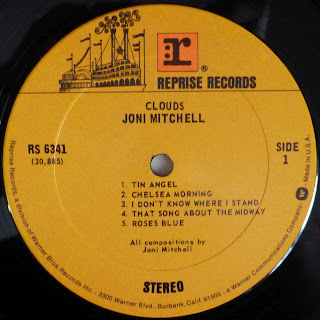 |
| A young Roberta Joan Anderson |
The reason I mention this is because we had a snowstorm a few days ago. And although it was only a few inches, it was enough to strand us indoors for a couple of days since we live on a very steep hill that never gets plowed. So I thought it would be a great time to take a look and listen to all the Joni Mitchell albums in my collection, which turns out to be exactly 30.
 |
| Song To A Seagull, 1968 |
 |
| 1968 first pressing |
 |
| 2nd pressing, 1970 |
Side 1: T 0 30753 RS6293A-1B AB 13
Side 2: T 1 30754 RS6293B-1L A
Pressed by Columbia Records at their Terre Haute, IN plant.
While my copy looks very clean, it has a number of ticks and some groove noise, no doubt caused by the cheap record player my brother and I used to listen to our albums. I would grade it a solid VG/VG. However, even if it were in better shape, this is just not a great-sounding album. Producer David Crosby had the bright idea of having Joni sing into an open grand piano, resulting in a rich, resonate sound, but also causing some high-level sympathetic string vibration that had to be filtered out later, along with most of the top end. (Which may be why the album has never been remastered.) That said, Stephen Still's bass on "Night In The City" is deep and punchy and the songs are terrific. I'll be looking for a cleaner copy at some point.
 |
| Clouds, 1969 |
 |
| Clouds, 1976 repressing |
 |
| Post-1974 Reprise Records label with sausage logo. |
Here are the matrix numbers for my three copies:
-1969 original pressing:
Side 1: 30885 1S I
Side 2: 30886 1S I
Pressed by RCA Records, Indianapolis, IN
-1970 repressing:
Side 1: 30885 RS 6341 A RE1-1L (S) C17 1Ƨ
Side 2: 30885 RS 6341 B RE-1 1-C (S) F T1
Side 1 stamper was made for Columbia Records' Santa Maria, CA pressing plant, while the side 2 stamper was made for Columbia's plant in Terre Haute, IN. For some reason, one of the stampers was sent to the other plant.
-1976 repressing:
Side 1: RS-6341 30885 RE1 A2 P
Side 2: RS-6341 30886 C P
Pressed by Columbia Records, Pittman, NJ
 |
| Ladies of the Canyon, 1970 |
As I mentioned at the top, Joni's third album, Ladies of the Canyon has long been my favorite of her albums. (Although lately I've been leaning a little more toward The Hissing Of Summer Lawn.) But I have a confession to make. The first song on Ladies of the Canyon is "Morning Morgantown," which is rose-colored memory of the brief time that Joni spent studying in the city that houses the University of West Virginia back in 1966 or 67. From that song, I somehow got the idea that the "Canyon" in the title referred to the mountains of West Virginia, and that the whole album was a kind of reverie to Wild, Wonderful, West Virginia. I was an East Coast kid, so how was I to know that the West Hollywood suburb of Laurel Canyon had become the center of the musical universe in the late 60s? It was only many years later that I had a big "DUH" moment and realized the title referred to Laurel Canyon where Joni lived at the time with her boyfriend Graham Nash (inspiring Nash's song "Our House"), while hanging out and making music with neighbors Stephen Stills, David Crosby, Mama Cass, Peter Tork, Frank Zappa, Jackson Browne, Neil Young, Jim Morrison, Roger McGuinn, and many others. I feel a little sheepish every time I play the record.
I have two copies of Ladies Of The Canyon. The first is my 1970 original pressing on the pumpkin-colored Reprise label. The album also appeared on the two-toned Reprise / Warner Seven Arts label, but since it came out the year that Reprise changed their labels, it was available on both labels from the start. The matrixes are the same.
 |
| 1970 original pressing |
 |
| 2009 Rhino Vinyl remastering |
-1970 original pressing:
Side 1: RS-6376 30992 C3 P
Side 2: RS-6376 30993 B3 P
Pressed by Columbia Records, Pittman, NJ
-2009 Rhino Vinyl remastering:
Side 1: R1-6376-A CB 18397.1(3)
Side 2: R1-6376-B CB 18397.2(3)
Remastered by Chris Bellman
Pressed by Record Technology Incorporated, Camarillo, CA
More to come.
Enjoy the music!




































